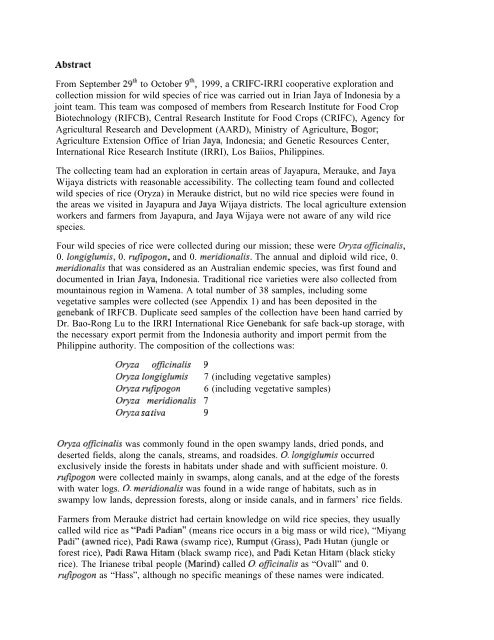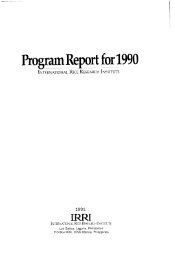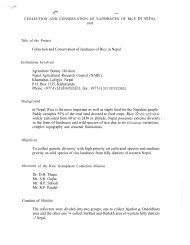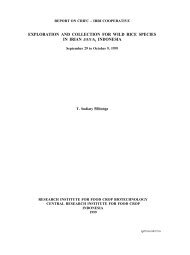Appendix 1 - IRRI
Appendix 1 - IRRI
Appendix 1 - IRRI
You also want an ePaper? Increase the reach of your titles
YUMPU automatically turns print PDFs into web optimized ePapers that Google loves.
Abstract<br />
From September 29’ to October gth, 1999, a CRIFC-<strong>IRRI</strong> cooperative exploration and<br />
collection mission for wild species of rice was carried out in Irian Jaya of Indonesia by a<br />
joint team. This team was composed of members from Research Institute for Food Crop<br />
Biotechnology (RIFCB), Central Research Institute for Food Crops (CRIFC), Agency for<br />
Agricultural Research and Development (AARD), Ministry of Agriculture, Bogor;<br />
Agriculture Extension Office of Irian Jaya, Indonesia; and Genetic Resources Center,<br />
International Rice Research Institute (<strong>IRRI</strong>), Los Baiios, Philippines.<br />
The collecting team had an exploration in certain areas of Jayapura, Merauke, and Jaya<br />
Wijaya districts with reasonable accessibility. The collecting team found and collected<br />
wild species of rice (Oryza) in Merauke district, but no wild rice species were found in<br />
the areas we visited in Jayapura and Jaya Wijaya districts. The local agriculture extension<br />
workers and farmers from Jayapura, and Jaya Wijaya were not aware of any wild rice<br />
species.<br />
Four wild species of rice were collected during our mission; these were Oryza ofjcinalis,<br />
0. Zongiglumis, 0. rufipogon, and 0. meridionalis. The annual and diploid wild rice, 0.<br />
meridionalis that was considered as an Australian endemic species, was first found and<br />
documented in Irian Jaya, Indonesia. Traditional rice varieties were also collected from<br />
mountainous region in Wamena. A total number of 38 samples, including some<br />
vegetative samples were collected (see <strong>Appendix</strong> 1) and has been deposited in the<br />
genebank of IRFCB. Duplicate seed samples of the collection have been hand carried by<br />
Dr. Bao-Rong Lu to the <strong>IRRI</strong> International Rice Genebank for safe back-up storage, with<br />
the necessary export permit from the Indonesia authority and import permit from the<br />
Philippine authority. The composition of the collections was:<br />
Oryza officinalis 9<br />
Oryza longiglumis 7 (including vegetative samples)<br />
Oryza rufipogon 6 (including vegetative samples)<br />
Oqza meridionalis 7<br />
Oryza sa tiva 9<br />
Oryza officinalis was commonly found in the open swampy lands, dried ponds, and<br />
deserted fields, along the canals, streams, and roadsides. 0. longiglumis occurred<br />
exclusively inside the forests in habitats under shade and with sufficient moisture. 0.<br />
rufipogon were collected mainly in swamps, along canals, and at the edge of the forests<br />
with water logs. 0. meridionalis was found in a wide range of habitats, such as in<br />
swampy low lands, depression forests, along or inside canals, and in farmers’ rice fields.<br />
Farmers from Merauke district had certain knowledge on wild rice species, they usually<br />
called wild rice as “Padi Padian” (means rice occurs in a big mass or wild rice), “Miyang<br />
Padi” (awned rice), Padi Rawa (swamp rice), Rumput (Grass), Padi Hutan (jungle or<br />
forest rice), Padi Rawa Hitam (black swamp rice), and Padi Ketan Hitam (black sticky<br />
rice). The Irianese tribal people (Marind) called 0. officinalis as “Ovall” and 0.<br />
rujpogon as “Hass”, although no specific meanings of these names were indicated.





